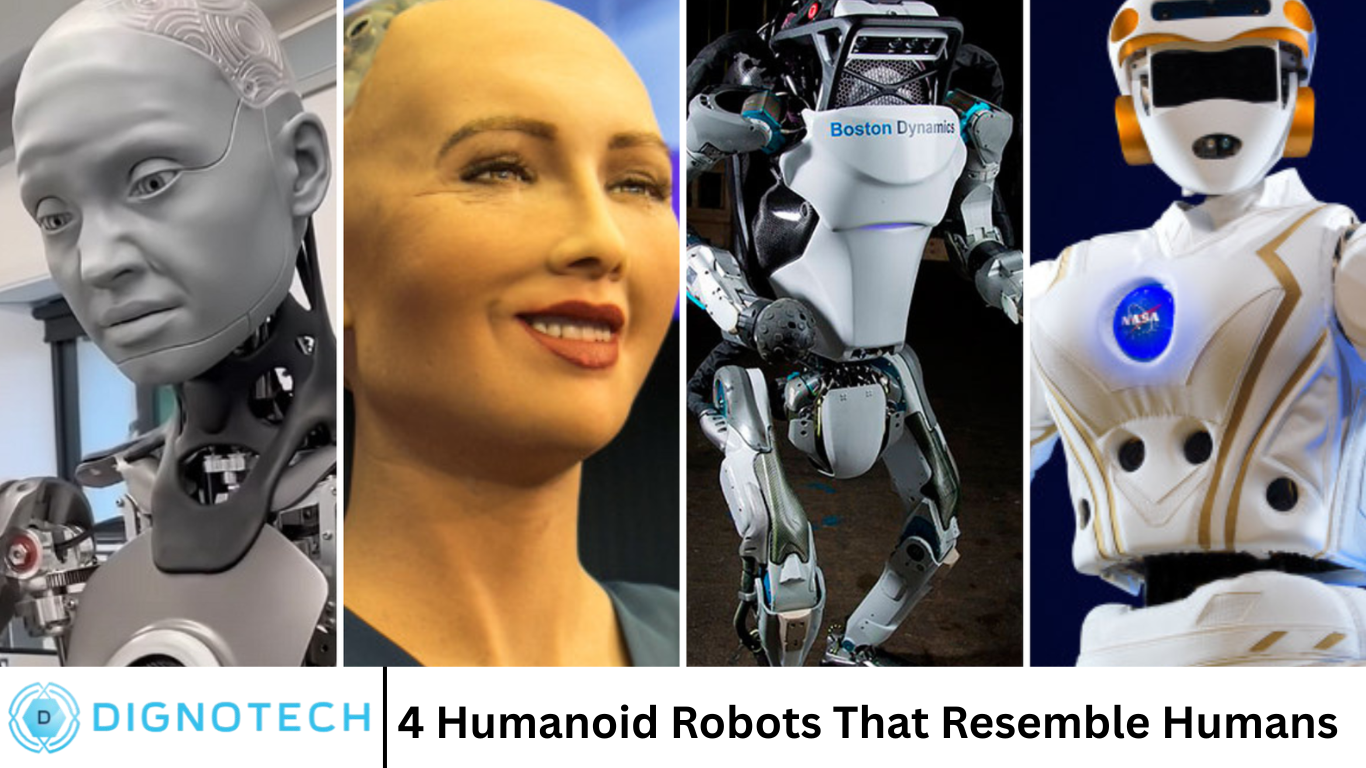4 Humanoid Robots That Resemble Humans

The world of robotics is rapidly advancing, and one of the most fascinating areas of development is the creation of humanoid robots—machines designed to resemble human beings in appearance, movements, and sometimes even behavior. These robots are not just a product of science fiction; they are a reality that showcases the remarkable progress we have made in the field of artificial intelligence (AI), engineering, and robotics. Humanoid robots are designed to interact with humans, assist in various tasks, and even mimic human expressions and emotions.
In this article, we will explore four notable humanoid robots that resemble humans, how they work, their features, and the implications they hold for the future. We will also address some frequently asked questions about humanoid robots to give you a comprehensive understanding of this innovative technology.
Sophia – The World-Famous Humanoid Robot
Sophia is arguably one of the most well-known humanoid robots in the world. Developed by Hong Kong-based Hanson Robotics, Sophia was activated in 2016 and quickly became a global sensation due to her lifelike appearance and ability to engage in conversations. Sophia is a social robot, designed to look like a human female with realistic facial features, including expressive eyes, a mouth that moves with speech, and facial expressions that make her seem almost human.
Sophia’s appearance is modeled after actress Audrey Hepburn, and her creators aimed to create a robot capable of interacting with people in a way that is both natural and engaging. Sophia uses artificial intelligence to process speech and engage in conversations, with the ability to recognize and respond to questions on a variety of topics. She can also remember past interactions and adapt her responses accordingly, which adds to the impression of a human-like intelligence.
Key Features of Sophia:
- Facial Expressions: Sophia’s face is equipped with a variety of expressions, including smiles, frowns, and even a look of surprise. This enables her to communicate emotions to a certain extent.
- AI Technology: Sophia uses an advanced AI system, which enables her to process speech, recognize faces, and engage in human-like interactions.
- Natural Language Processing (NLP): Sophia is capable of understanding and responding to human language in real-time.
- Autonomous Learning: Sophia can learn from conversations and adapt her responses accordingly.
- Public Appearances: Sophia has made several public appearances, including at the United Nations and the World Economic Forum.
Sophia has sparked many debates on the future of artificial intelligence and its ethical implications, particularly around the idea of robots that can mimic human behavior and even form relationships with humans.
ASIMO – Honda’s Humanoid Robot
ASIMO, developed by Honda, is another iconic humanoid robot that closely resembles a human being. Unlike Sophia, ASIMO is designed to focus primarily on mobility, making it a robot that excels at movement and physical tasks. First introduced in 2000, ASIMO was one of the first humanoid robots to showcase bipedal walking, running, and even dancing. ASIMO’s humanoid design allows it to perform tasks such as opening doors, serving drinks, and navigating complex environments, making it an ideal candidate for applications in environments like airports, hospitals, and homes.
ASIMO is often regarded as a pioneer in humanoid robotics due to its exceptional ability to mimic human-like movements. The robot can walk, run, climb stairs, and even interact with humans in a variety of ways. Its advanced sensors and cameras help it navigate and recognize people, and its algorithms allow it to respond to commands and adjust to its environment.
Key Features of ASIMO:
- Mobility: ASIMO can walk, run, and climb stairs with great stability, making it one of the most mobile humanoid robots.
- Gesture Recognition: ASIMO can recognize and respond to human gestures, such as waving or pointing.
- Interaction: ASIMO is equipped with the ability to engage in basic interactions with humans, such as shaking hands and following voice commands.
- Autonomous Operation: ASIMO can operate autonomously, navigating through environments without the need for constant human intervention.
- Entertainment: ASIMO is also capable of performing entertaining dances and routines, which has made it a favorite at exhibitions and events.
Although Honda discontinued the development of ASIMO in 2018, the robot remains an iconic symbol of what is possible in the field of humanoid robotics, especially in terms of mobility and human-robot interaction.
Pepper – The Social Robot
Pepper is a humanoid robot created by SoftBank Robotics, designed primarily to interact with people in social environments. Released in 2014, Pepper is known for its ability to recognize emotions and respond accordingly. It can detect human emotions through facial expressions and voice tones, and it can engage in basic conversations with users.
What makes Pepper unique is its role in customer service and companionship. The robot is used in retail stores, hospitals, and even in some homes as a companion robot. Pepper’s emotional intelligence and ability to understand human interactions make it particularly effective in environments where empathy and social engagement are key.
Key Features of Pepper:
- Emotion Recognition: Pepper uses advanced sensors and AI to recognize emotions in people, including happiness, sadness, and surprise. This allows it to respond appropriately in social contexts.
- Voice and Gesture Interaction: Pepper can understand voice commands and can also respond to gestures and body language.
- AI-driven Conversations: Pepper engages in conversations using natural language processing, allowing it to understand and respond to a wide range of topics.
- Multifunctional: Pepper is used in a variety of settings, from retail stores where it assists customers, to homes where it offers companionship.
Pepper represents a step forward in the development of robots that can interact with humans on a social level, fostering positive human-robot relationships in various contexts.
Atlas – The Agile Humanoid Robot
Atlas, developed by Boston Dynamics, is one of the most impressive examples of a humanoid robot focused on agility and mobility. Unlike other humanoid robots designed for human interaction or communication, Atlas is built for physical tasks that require strength and precision. Atlas is capable of performing acrobatic feats such as running, jumping, backflips, and even navigating rough terrain. The robot’s movements are powered by a combination of hydraulic actuators and advanced control systems that allow it to perform these complex maneuvers.
Atlas has been designed for military and industrial applications, where its agility and strength could be put to use in environments that are too hazardous for humans. Its ability to carry heavy loads, maintain balance, and navigate rough terrains makes it ideal for search-and-rescue missions and other physically demanding tasks.
Key Features of Atlas:
- Agility: Atlas can perform advanced movements like backflips, running, and jumping, showcasing exceptional agility.
- Balance: Atlas is equipped with sensors and algorithms that allow it to maintain balance even in challenging environments, such as rough terrain or during physical exertion.
- Versatility: Atlas is capable of performing a variety of tasks, from lifting heavy objects to performing complex maneuvers.
- Autonomy: Atlas operates autonomously, making decisions based on its environment and tasks at hand.
- Rescue and Industrial Applications: Atlas has potential applications in areas such as search-and-rescue missions, disaster relief, and industrial environments.
While Atlas is not designed to resemble humans in the same way as Sophia or Pepper, its humanoid form and incredible agility make it a remarkable achievement in the world of robotics.
Frequently Asked Question
What are humanoid robots?
Humanoid robots are robots designed to resemble human beings in appearance, behavior, and sometimes even emotions. They are equipped with sensors, AI, and advanced systems that enable them to interact with humans in natural ways.
What is the purpose of humanoid robots?
The primary purpose of humanoid robots is to assist humans in various tasks, including communication, caregiving, entertainment, and physical labor. They can also perform tasks in dangerous environments, such as search-and-rescue missions.
Can humanoid robots feel emotions?
While humanoid robots like Pepper and Sophia can recognize human emotions through facial expressions and voice tones, they do not truly “feel” emotions. Their responses are based on algorithms and programming designed to simulate empathy.
What is the most advanced humanoid robot?
Sophia, developed by Hanson Robotics, is often considered the most advanced humanoid robot due to her human-like appearance and ability to engage in meaningful conversations. Other robots like ASIMO and Atlas are also highly advanced in their respective fields of mobility and agility.
Are humanoid robots dangerous?
While humanoid robots have the potential to be used in harmful ways, most humanoid robots are designed with safety features in place. The primary concerns around humanoid robots involve ethical implications, such as privacy, autonomy, and the displacement of human workers.
What industries use humanoid robots?
Humanoid robots are used in various industries, including healthcare, customer service, retail, entertainment, and manufacturing. They are also being explored for use in military and rescue operations.
Will humanoid robots replace humans in the future?
While humanoid robots are becoming more advanced, it is unlikely that they will fully replace humans. Instead, they will complement human abilities and assist with tasks that are dangerous, repetitive, or physically demanding.
Conclusion
Humanoid robots have come a long way since their inception, and the advancements in AI, robotics, and engineering have made it possible to create machines that closely resemble humans in both form and function. From Sophia’s lifelike expressions to ASIMO’s graceful movements and Atlas’s incredible agility, these robots are redefining what it means to interact with machines. As technology continues to evolve, we can expect to see even more impressive humanoid robots that will play a vital role in shaping our future. Whether they are used for companionship, assistance, or specialized tasks, humanoid robots are here to stay and will continue to change the way we live and work.





